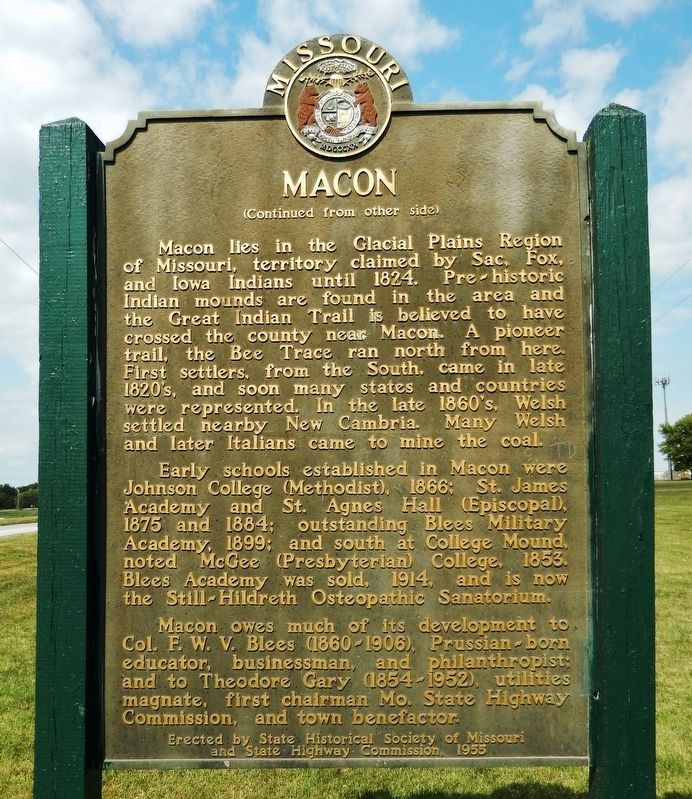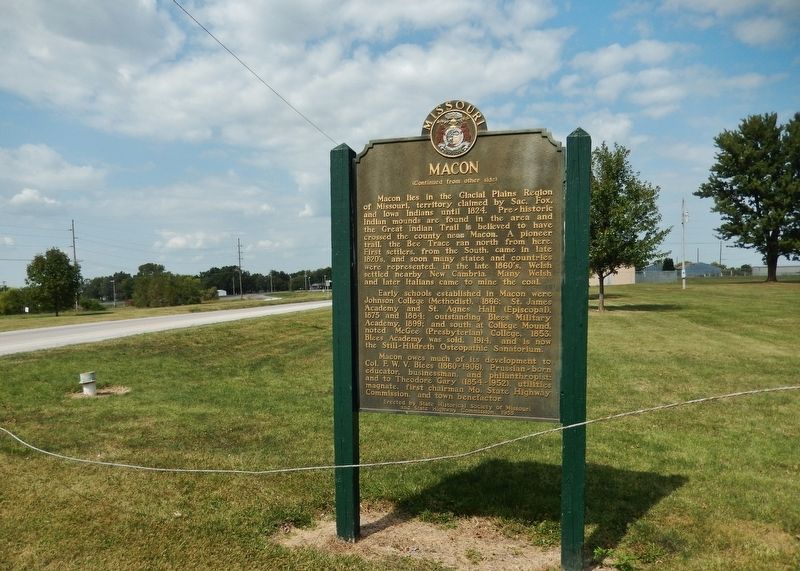Macon in Macon County, Missouri — The American Midwest (Upper Plains)
Macon
(side 1)
Macon is the seat of justice for one of Missouri's richest coal bearing counties. The town was laid out on rolling upland prairie, between the Middle Fork of the Salt and the East Fork of the Chariton rivers, 1856. Hudson, named for a railroad official, was laid out just west, 1857, and both towns joined as Macon City, 1859. The Hannibal and St. Joseph (Burlington) reached here, 1858, and the North Missouri (Wabash), 1859.
A railroad center, Macon was a Union troop concentration point in the Civil War, and it replaced pro-Southern Bloomington as seat of Macon County, 1863. Organized, 1837, the county is named for Nathaniel Macon, Revolutionary War soldier and N.C. statesman. Here 11 military parole violators were executed by order of Union General Lewis Merrill, Sept. 26, 1862.
Macon County, through which passes the Great Divide between the Mississippi and Missouri rivers, abounds in bituminous coal deposits. A prime coal producer, the county was first in the state, 1891-1913. Coal was first discovered at nearby Bevier, laid out, 1858, named for Col. Robert S. Bevier.
(side 2)
Early schools established in Macon were Johnson College (Methodist), 1866; St. James Academy and St. Agnes Hall (Episcopal), 1875 and 1884; outstanding Blees Military Academy, 1899; and south at College Mound, noted McGee (Presbyterian) College, 1853. Blees Academy was sold, 1914, and is now the Still-Hildreth Osteopathic Sanatorium.
Macon owes much of its development to Col. F.W.V. Blees (1860-1906), Prussian-born educator, businessman, and philanthropist; and to Theodore Gary (1854-1952), utilities magnate, first chairman Mo. State Highway Commission, and town benefactor.
Erected 1955 by State Historical Society of Missouri and State Highway Commission.
Topics and series. This historical marker is listed in these topic lists: Education • Native Americans • Railroads & Streetcars • Settlements & Settlers. In addition, it is included in the Missouri, The State Historical Society of series list.
Location. 39° 43.293′ N, 92° 27.906′ W. Marker is in Macon, Missouri, in Macon County. Marker is at the intersection of South Missouri Street (U.S. 63) and County Park Drive (Lake View Drive), on the right when traveling north on South Missouri Street. Marker is located near the northeast corner of the intersection. Touch for map. Marker is in this post office area: Macon MO 63552, United States of America. Touch for directions.
Other nearby markers. At least 3 other markers are within 13 miles of this marker, measured as the crow flies. Built 1864~65 (approx. 1˝ miles away); Bevier & Southern Locomotive No. 112 (approx. 5.6 miles away); Dr. Owen L. Woodward (approx. 12.3 miles away).
Credits. This page was last revised on September 15, 2020. It was originally submitted on September 14, 2020, by Cosmos Mariner of Cape Canaveral, Florida. This page has been viewed 282 times since then and 38 times this year. Photos: 1. submitted on September 14, 2020, by Cosmos Mariner of Cape Canaveral, Florida. 2. submitted on September 15, 2020, by Cosmos Mariner of Cape Canaveral, Florida.
Editor’s want-list for this marker. photo of side 1 • Can you help?

